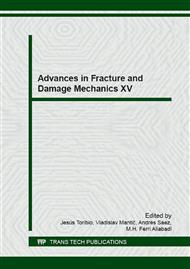[1]
S. Abrate. Impact on composite structures. Cambridge (UK): Cambridge University Press (1998).
Google Scholar
[2]
C.S. Lopes, O. Seresta, Y. Coquet, Z. Gnrdal, P.P. Camanho, B. Thuis. Low-velocity impact damage on dispersed stacking sequence laminates. Part I: experiments. Compos Sci Technol 2009; 69: 926-36.
DOI: 10.1016/j.compscitech.2009.02.009
Google Scholar
[3]
C. Li, N. Hu, Y. Yin, H. Sekine, H. Fukunaga. Low-velocity impact-induced damage of continuous fiber-reinforced composite laminates. Part I. An FEM numerical model. Composites Part A 2002; 33: 1055-62.
DOI: 10.1016/s1359-835x(02)00081-7
Google Scholar
[4]
F. Aymerich, F. Dore, P. Priolo. Simulation of multiple delaminations in impacted cross-ply laminates using a finite element model based on cohesive interface elements. Compos Sci Technol 2009; 69: 1699-709.
DOI: 10.1016/j.compscitech.2008.10.025
Google Scholar
[5]
M.R. Wisnom. Modelling discrete failures in composites with interface elements. Compos A Appl Sci Manuf 2010; 41(7): 795-805.
DOI: 10.1016/j.compositesa.2010.02.011
Google Scholar
[6]
A. Riccio, G. Di Felice, S. Saputo, F. Scaramuzzino. A Numerical Study on Low velocity impact induced damage in stiffened composite panels. Journal of Computational Simulation and Modeling 2013; 3(1): 044-047.
DOI: 10.1016/j.proeng.2014.11.148
Google Scholar
[7]
P.P. Camanho, C.G. Davila, M.F. De Moura. Numerical simulation of mixed-mode progressive delamination in composite materials. J Compos Mater 2003; 37(16): 1415–38.
DOI: 10.1177/0021998303034505
Google Scholar
[8]
A.M. Amaro, J.B. Santos, J.S. Cirne. Delamination depth in composites laminates with interface elements and ultrasound analysis. Strain 2011; 47(2): 138–45.
DOI: 10.1111/j.1475-1305.2008.00491.x
Google Scholar
[9]
C. Bouvet, N. Hongkarnjanakul, S. Rivallant, J.J. Barrau. Discrete impact modeling of inter- and intra-laminar failure in composites. In: S. Abrate, B. Castanié, Y.D.S. Rajapakse, editors. Dynamic failure of composite and sandwich structures. Dordrecht: Springer; 2013: 339–92.
DOI: 10.1007/978-94-007-5329-7_8
Google Scholar
[10]
P. Maimí, P.P. Camanho, J.A. Mayugo, C.G. Dávila. A continuum damage model for composite laminates: Part I – constitutive model. Mech Mater 2007; 39: 897–908.
DOI: 10.1016/j.mechmat.2007.03.005
Google Scholar
[11]
Z. Hashin. Failure criteria for unidirectional fiber composites. Journal of Applied Mechanics 1980; 47: 329-334.
DOI: 10.1115/1.3153664
Google Scholar
[12]
A. Puck, H. Schurmann. Failure analysis of FRP laminates by means of physically based phenomenological models. Composites Science and Technology 1998; 58: 1045-1067.
DOI: 10.1016/s0266-3538(96)00140-6
Google Scholar
[13]
A. Sellitto, R. Borrelli, F. Caputo, A. Riccio, F. Scaramuzzino. Methodological approaches for kinematic coupling of non-matching finite element meshes. Procedia Engineering 2011; 10: 421-426.
DOI: 10.1016/j.proeng.2011.04.071
Google Scholar


